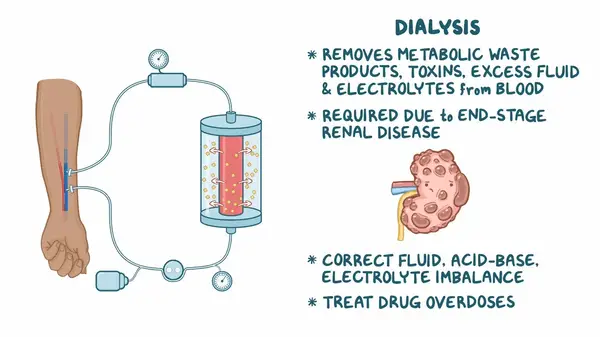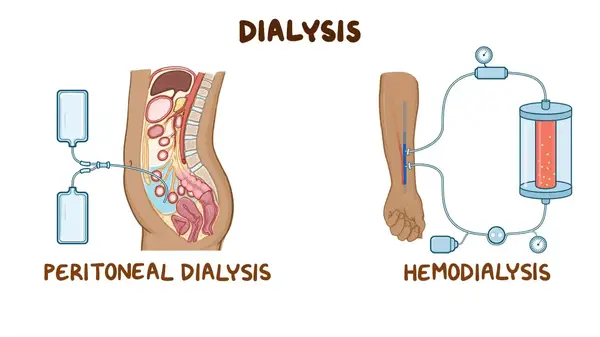Dialysis treatment options have become increasingly crucial for over half a million Americans requiring regular kidney replacement therapy. Recent events, including Hurricane Helene’s impact on North Carolina, highlighted the vulnerability of dialysis patients when medical supply chains are disrupted. The storm affected a major dialysate manufacturer, creating concerns about treatment accessibility for patients nationwide. This situation emphasized the critical need for robust emergency planning in kidney failure treatment programs.
Contents
Understanding Kidney Failure and Dialysis Necessity
When kidneys fail to filter waste products and excess fluids from the blood, dialysis treatment options become life-sustaining interventions. End-stage renal disease (ESRD) typically develops from underlying conditions, with diabetes mellitus and hypertension being the primary cause. Othe significant factors contributing to kidney failure treatment needs include obstructive nephropathy and glomerulonephritis. Healthcare providers carefully monitor patients’ kidney function through various tests to determine when dialysis becomes necessary. Learn more about Ritual Multi Vegan Supplements.

Types of Dialysis Procedures
Two main dialysis treatment options exist for patients with kidney failure. Hemodialysis procedure involves filtering blood outside the body through an artificial kidney machine, typically requiring three weekly sessions at specialized centers. Meanwhile, peritoneal dialysis care utilizes the patient’s abdominal lining as a natural filter, offering more flexibility for home-based treatment. Each method has distinct advantages and considerations that healthcare providers discuss with patients to determine the most suitable approach. Transform your Health with Ora Organics.
Hemodialysis: Process and Requirements
During the hemodialysis procedure, blood flows through a specialized machine that removes waste products and excess fluids. This kidney failure treatment requires creating a permanent access point, usually through a fistula in the arm. Sessions typically last several hours, with patients visiting dialysis centers three times weekly. The procedure requires specialized equipment and trained medical staff to monitor the entire process. Many patients choose this option due to its structured approach and direct medical supervision. See NFL Ticket Exchange: Your source for all NFL Tickets.
Understanding Peritoneal Dialysis
Peritoneal dialysis care involves a catheter permanently placed in the abdomen. This dialysis treatment option allows patients to perform treatments at home, offering greater independence. Thie process uses dialysis solution to absorb waste through the peritoneal membrane, requiring more frequent but shorter sessions than hemodialysis. Patients must undergo comprehensive training to perform the procedure safely and maintain strict hygiene protocols. The flexibility of this method often appeals to working professionals and those who prefer managing their care at home.
Managing Dialysis Complications
Both dialysis treatment options carry potential risks that require careful monitoring. Common dialysis complications can include infection risk, blood pressure fluctuations, and anemia. Hemodialysis patients may experience access site problems, while peritoneal dialysis care cand lead to peritonitis. Regular monitoring through laboratory tests, including Blood Urea Nitrogen (BUN), creatinine levels, and estimated glomerular filtration rate (eGFR), helps healthcare providers manage these potential complications effectively. Maintaining proper nutrition and following medication schedules are crucial aspects of successful treatment outcomes.

The Impact of Supply Chain Disruptions
Approximately 15% of kidney failure treatment occurs at home, primarily through peritoneal dialysis. When Hurricane Helen affected Baxter International, a major dialysate manufacturer, it highlighted the vulnerability of the supply chain. Alternative manufacturers, like Fresnius Medical Care. Increased production to maintain continuous peritoneal dialysis care for affected patients. This situation demonstrated the importance of having multiple suppliers and backup plans for essential medical supplies. See Osprey Lifestyle gear for hiking, biking and travel.

Supporting Dialysis Patients During Crises
During the supply shortage, some patients temporarily switched to hemodialysis procedure, while other modified their peritoneal dialysis schedule. The industry’s quick response demonstrated its commitment to maintaining essential kidney failure treatment services during emergencies. Support systems and emergency protocols were put in place to ensure patient safety and continued care throughout the crisis period.
As medical technology advances, dialysis treatment options continue to evolve. Healthcare providers and manufacturers continue to develop more efficient and accessible kidney failure treatment methods.
This article is for informational purposes only. As always please contact your healthcare provider for proper evaluation and personalized treatment recommendations.
Barry Schustermann
Follow me on X @BarrySchust
Follow me on Facebook @Barry Schustermann
External References:
1 National Kidney Foundation – Dialysis
https://www.kidney.org/atoz/content/dialysisinfo
2 Mayo Clinic – Hemodialysis
https://www.mayoclinic.org/tests-procedures/hemodialysis/about/pac-20384824
3 National Institute of Diabetes and Digestive and Kidney Diseases – Peritoneal Dialysis
https://www.niddk.nih.gov/health-information/kidney-disease/kidney-failure/peritoneal-dialysis
4 American Kidney Fund – Dialysis
https://www.kidneyfund.org/kidney-disease/kidney-failure/dialysis/
5 Centers for Disease Control and Prevention – Chronic Kidney Disease in the United States, 2021
https://www.cdc.gov/kidneydisease/publications-resources/ckd-national-facts.html



